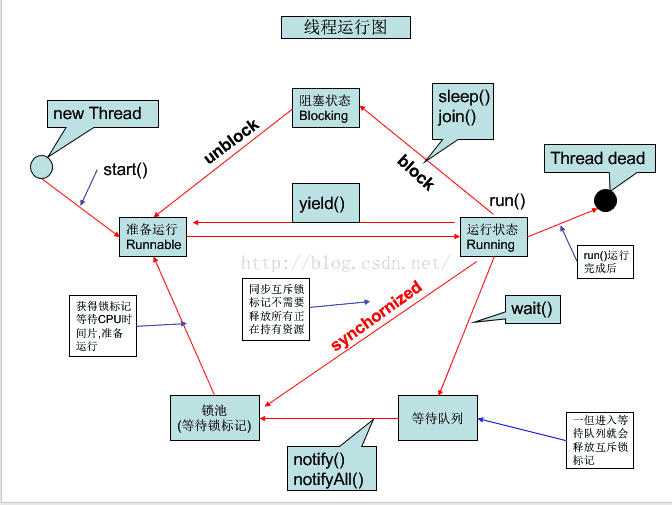Java多线程 Java多线程状态及方法实例解析
戈德里克山谷 人气:0这篇文章主要介绍了Java多线程状态及方法实例解析,文中通过示例代码介绍的非常详细,对大家的学习或者工作具有一定的参考学习价值,需要的朋友可以参考下
首先介绍线程的五种状态:
新生态:New Thread()
就绪态:准备抢CPU时间片
运行态:抢到了CPU时间片
阻塞态:放弃已经抢到的CPU时间片,且暂时不参与争抢
死亡态:Run运行完了之后

接下来介绍三种方法:线程的阻塞,线程的优先级设置,线程的礼让
public class MutliThreadDemo4 {
public static void main(String[] args) {
threadBlock();
//threadPriority();
//threadYield();
}
/**
* 线程的阻塞
*/
private static void threadBlock() {
//创建Runnable接口实现类的对象
Runnable r = () -> {
for(int i = 0; i < 10; i++) {
System.out.println(Thread.currentThread().getName() + ":" + i);
//线程休眠(由运行状态到阻塞状态,时间过了回到就绪态,重新争抢),直观上表现为停顿打印
try {
Thread.sleep(1000);
}catch(InterruptedException e){
e.printStackTrace();
}
}
};
//实例化
new Thread(r, "甲").start();
}
/**
* 线程的优先级
*/
private static void threadPriority() {
Runnable r = () -> {
for(int i = 0; i < 10; i++) {
System.out.println(Thread.currentThread().getName() + ":" + i);
}
};
Thread t1 = new Thread(r, "甲");
Thread t2 = new Thread(r, "乙");
//设置优先级,必须在开始执行(start)之前
//设置线程的优先级,只是修改这个线程可以去抢到CPU时间片的概率。
//并不是优先级高的线程一定能抢到CPU时间片
//优先级的设置,是一个整数(0,10]的整数,默认是5
t1.setPriority(10);
t2.setPriority(1);
t1.start();
t2.start();
}
/**
* 线程的礼让
*/
private static void threadYield() {
//线程释放自己的CPU资源,由运行状态,回到就绪状态
//匿名内部类
Runnable r = new Runnable() {
public void run() {
for (int i = 0; i < 10; i++) {
System.out.println(Thread.currentThread().getName() + ":" + i);
if (i == 3) {
Thread.yield();
}
}
}
};
Thread thread1 = new Thread(r, "thread-1");
Thread thread2 = new Thread(r, "thread-2");
thread1.start();
thread2.start();
}
}
加载全部内容